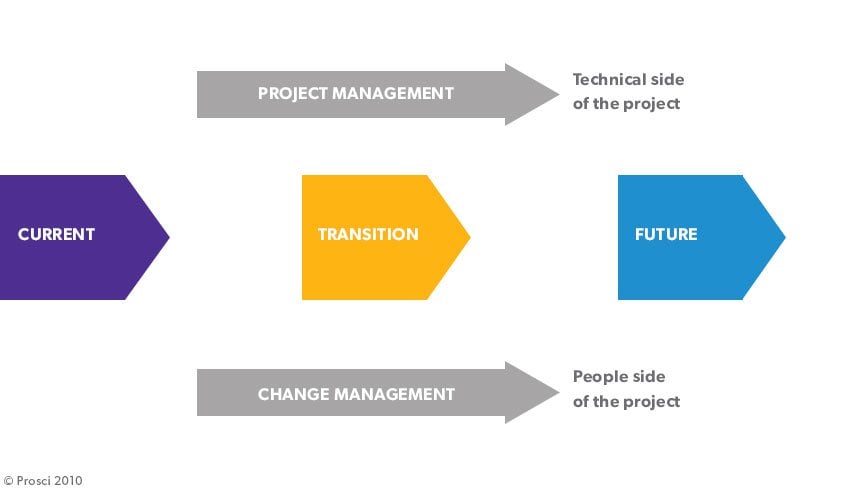
Change is inevitable. But it’s how you lead and manage change that makes the difference. Companies that accept and embrace change are healthier, more dynamic, and faster growing than those companies that fear change.
Tom Ault, Director of Technical Training at ERC and Senior Consultant, talks about leading and managing change.
Stop, challenge & choose
When faced with change, we typically put our own negative spin on it, often without knowing all the facts. Our natural tendency is to see change as a threat—our brains are hardwired to be risk averse—rather than seeing the positives.
There are three simple commands that we teach people to consciously think about when dealing with a perceived negative like change.
- Stop: When change first occurs, do not automatically turn to a negative response. Instead, stop, and don’t act or decide anything. Mentally disconnect and take a deep breath. Try to center yourself and observe the change that is happening.
- Challenge: Now that you had a moment to process instead of react, challenge yourself to find positives in the situation. Ask yourself “What am I telling myself? What evidence do I have that supports or contradicts my interpretation, and what are other possible interpretations?
- Choose: Once you have challenged yourself to find the silver lining in the change, ask yourself “What would have been my ideal response?” And “What interpretation would help me produce my ideal response?” Once you choose it, make sure to use it!
Three levels of change
Change in organizations happen at three levels: How you manage yourself, how you relate to others, and how to lead across the organization.
- It starts with yourself since it is difficult to lead others through change if you are not committed.
- Next is leading others. You have to be able to go by these rules:
- I can be a role model and encourage people that work in my team on how best to react to change.
- I have to be sensitive to their reactions and feelings to help them manage through it.
- Not everyone will react the same way and have the same feelings.
It is important to get those feelings out in the open; so it’s best to address them.
- And last, leading across organizations requires understanding that change is an individual choice and needs to happen one person at a time. Communication in various forms and on a regular basis is important if you want people to buy in. There must also be a feedback loop where you actively solicit concerns and roadblocks to change so they can be addressed.
So ask yourself these questions when dealing with these levels of change:
Self | Others | Organizationally |
|
|
|
Every person within an organization has a roll when it comes to organizational change. In order to have effective change, there must be involvement and action displayed by many within the organization.

The image above helps to visualize that change occurs along two main paths: a project management path that focuses on the system or process changes, and a change management path that focuses on the people side of the change. Many organizations focus on the project path and are then surprised when there is no buy-in from their people.
Organizations that assign these roles and responsibilities to a change initiative will find better success:
Change Management | This group can be made up of one or more change agents who monitor the people side of change by checking for resistance and ensuring the other roles are in alignment and are focused on their roles. |
Senior Leader | This group is the top contributor to the overall project success according to Prosci, Inc. benchmarking studies. Senior leaders are one of two preferred senders of messages about change. The role of this group is to participate actively and visibly throughout the project. They build the needed coalition of sponsorship with peers and other managers. They also communicate the business message about effective change with employees. |
Managers & Supervisors | Managers and supervisors are the other preferred sender of messages about change. This group has a unique and well-developed relationship with the employees being impacted by the change. But what is this group’s role? They communicate the personal messages about the change with their direct reports, conduct group and individual coaching sessions and identify, analyze and manage resistance. They also provide feedback to the appropriate levels in the organization. |
Employees | This group makes changes to how they do their day-to-day work. Their acceptance and use of the solution determines the success of the project and the ongoing benefit derived from the change. This group’s role is to seek out information related to the business reasons for change and the personal impact of the change. They provide feedback and reaction to the change and the change management efforts. A key role is for this group to be proactive when dealing with change, rather than being “victims” of a change. |
Project Team | This group designs and develops the ‘change’—they are the ones who introduce new processes, systems, tools, job roles and responsibilities. They also provide much of the specific information about the change to the other stakeholders. This group’s role is to provide timely, accurate and succinct information about the change (or project). They also integrate change management activities into project management plans and activities. |
Why do people resist change?
Managers and employees resist change for different reasons. Managers may fear losing control and authority, comfort with the status quo, have no involvement in solution design, or have an answer for what’s in it for them.
Employees resist change due to lack of awareness, fear of the unknown, lack of job security and sponsorship.
Whatever the reason for resistance, change is inevitable. It’s how you deal with it yourself, with others and with your organization that will depend on if your company will spiral out of control or grow and conquer.

Change Management Training Course
In ERC’s Change Management training, participants will learn strategies for helping themselves, as well as others, through change. They will acquire the confidence and skills needed to face change.

